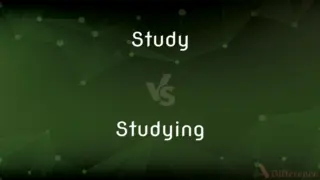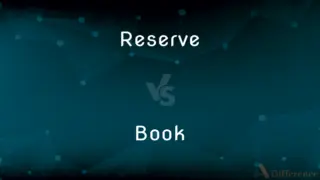Bent vs. Angular — What's the Difference?
By Tayyaba Rehman & Maham Liaqat — Updated on April 5, 2024
"Bent" describes a curve or angle formed by alteration from a straight form, implying flexibility or deformation, whereas "angular" refers to something having one or more angles, often suggesting sharpness or defined shapes.

Difference Between Bent and Angular
Table of Contents
ADVERTISEMENT
Key Differences
A bent object has been altered from its original straight shape, usually due to force or a natural disposition to curve. This can apply to physical objects that are curved or twisted and to metaphorical concepts, such as a person's bent towards a particular interest. On the other hand, angular describes an object or design characterized by sharp angles and clear, defined lines. It often conveys a sense of precision and deliberate design, as opposed to the more organic or involuntary shape of something bent.
While a bent form suggests a smooth curve or a gentle deviation from straightness, angular forms are defined by their clear, often abrupt, changes in direction. This distinction is particularly notable in design and aesthetics, where bent shapes might be used to convey fluidity and grace, whereas angular shapes convey structure and boldness.
The process of becoming bent usually involves an external force or pressure that causes the object to change shape. Conversely, angularity is a built-in characteristic of an object's design, implying intentionality in its form. For example, a tree branch might become bent due to wind, but a crystal naturally forms angular shapes.
Bent shapes are often associated with flexibility and adaptability, suggesting an ability to yield without breaking. Angular shapes, however, emphasize stability and rigidity, indicating a firmness or resistance to change. This conceptual difference extends to personality descriptions, where someone described as "bent" may be seen as flexible or resilient, while "angular" can imply a sharp or rigid personality.
The key difference lies in the implications of each term: "bent" emphasizes alteration and flexibility, often resulting from external forces, while "angular" focuses on the presence of deliberate angles, suggesting precision and defined boundaries.
ADVERTISEMENT
Comparison Chart
Definition
Altered from straight to curved or angled form.
Having clear, defined angles and sharp corners.
Connotation
Flexibility, deformation.
Precision, sharpness.
Implication
Alteration due to force or natural disposition.
Intentionality in design, natural sharpness.
Associated With
Organic shapes, smooth curves.
Structured design, clear lines.
Suggests
Adaptability, resilience.
Stability, rigidity.
Compare with Definitions
Bent
Deviating from the norm.
The path was bent around the lake.
Angular
Having a clear, defined shape or form.
His angular face was striking.
Bent
Altered from a straight form to a curved one.
The heavy snow left the tree branches bent.
Angular
Lacking grace or smoothness; awkward.
His dance moves were awkward and angular.
Bent
Having a natural inclination or tendency.
He has a bent for mathematics.
Angular
Characterized by sharp points and edges.
The modern building's angular design stood out.
Bent
Flexible or yielding in character.
Her bent personality made her well-liked.
Angular
Precisely measured or delineated.
The sculpture was composed of angular, intersecting planes.
Bent
Deformed or curved under pressure.
The metal rod was bent after the accident.
Angular
Relating to an angle or angles.
The artist's work featured angular compositions.
Bent
Past tense and past participle of bend1.
Angular
Having, forming, or consisting of an angle or angles.
Bent
Altered from an originally straight or even condition
Picked up pieces of bent wire.
Angular
Measured by an angle or by degrees of an arc.
Bent
Determined to take a course of action
I was bent on going to the concert.
Angular
Bony and lean; gaunt
An angular face.
Bent
Chiefly British Corrupt; venal.
Angular
Lacking grace or smoothness; awkward
An angular gait.
Bent
A tendency, disposition, or inclination
"The natural bent of my mind was to science" (Thomas Paine).
Angular
Rigid, stiff, and unyielding in character or disposition
"the cold, angular brand of materialism" (David K. Willis).
Bent
A transverse structural member or framework that is used for strengthening a bridge or trestle.
Angular
Relating or pertaining to an angle, or angles.
Bent
Bentgrass.
Angular
Having an angle or angles; forming an angle or corner
Bent
The stiff stalk of various grasses.
Angular
Sharp-cornered; pointed.
An angular figure
Bent
An area of grassland unbounded by hedges or fences.
Angular
Measured by an angle.
Angular distance
Bent
Simple past tense and past participle of bend
Angular
Lean, lank.
Bent
(Of something that is usually straight) Folded, dented.
Angular
Ungraceful; lacking grace.
Bent
Corrupt, dishonest.
Angular
(figuratively) Sharp and stiff in character.
He's remarkably angular in his habits and appearance.
She is an angular female.
Bent
Determined or insistent.
He was bent on going to Texas, but not even he could say why.
They were bent on mischief.
Angular
(organic chemistry) Composed of three or more rings attached to a single carbon atom (the rings not all being in the same plane).
Bent
(Of a person) leading a life of crime.
Angular
(anatomy) A bone in the base of the lower jaw of many birds, reptiles, and fishes.
Bent
Inaccurately aimed.
That shot was so bent it left the pitch.
Angular
Relating to an angle or to angles; having an angle or angles; forming an angle or corner; sharp-cornered; pointed; as, an angular figure.
Bent
Suffering from the bends.
Angular
Measured by an angle; as, angular distance.
Bent
(slang) High from both marijuana and alcohol.
Man, I am so bent right now!
Angular
Fig.: Lean; lank; raw-boned; ungraceful; sharp and stiff in character; as, remarkably angular in his habits and appearance; an angular female.
Bent
An inclination or talent.
He had a natural bent for painting.
Angular
A bone in the base of the lower jaw of many birds, reptiles, and fishes.
Bent
A predisposition to act or react in a particular way.
His mind was of a technical bent.
Angular
Measured by an angle or by the rate of change of an angle;
Angular momentum
Bent
The state of being curved, crooked, or inclined from a straight line; flexure; curvity.
The bent of a bow
Angular
Having angles or an angular shape
Bent
A declivity or slope, as of a hill.
Bent
Particular direction or tendency; flexion; course.
Bent
(carpentry) A transverse frame of a framed structure; a subunit of framing.
Bent
Such a subunit as a component of a barn's framing, joined to other bents by girts and summer beams.
Bent
Such a subunit as a reinforcement to, or integral part of, a bridge's framing.
Bent
Tension; force of acting; energy; impetus.
Bent
Any of various stiff or reedy grasses.
Bent
A grassy area, grassland.
Bent
The old dried stalks of grasses.
Bent
Changed by pressure so as to be no longer straight; crooked; as, a bent pin; a bent lever.
Bent
Strongly inclined toward something, so as to be resolved, determined, set, etc.; - said of the mind, character, disposition, desires, etc., and used with on; as, to be bent on going to college; he is bent on mischief.
Bent
The state of being curved, crooked, or inclined from a straight line; flexure; curvity; as, the bent of a bow.
Bent
A declivity or slope, as of a hill.
Bent
A leaning or bias; proclivity; tendency of mind; inclination; disposition; purpose; aim.
With a native bent did good pursue.
Bent
Particular direction or tendency; flexion; course.
Bents and turns of the matter.
Bent
A transverse frame of a framed structure.
Bent
Tension; force of acting; energy; impetus.
The full bent and stress of the soul.
Bent
A reedlike grass; a stalk of stiff, coarse grass.
His spear a bent, both stiff and strong.
Bent
A grass of the genus Agrostis, esp. Agrostis vulgaris, or redtop. The name is also used of many other grasses, esp. in America.
Bent
Any neglected field or broken ground; a common; a moor.
Bowmen bickered upon the bent.
Bent
A relatively permanent inclination to react in a particular way;
The set of his mind was obvious
Bent
Grass for pastures and lawns especially bowling and putting greens
Bent
A special way of doing something;
He had a bent for it
He had a special knack for getting into trouble
He couldn't get the hang of it
Bent
Altered from an originally straight condition;
A bent wire
Bent
Fixed in your purpose;
Bent on going to the theater
Dead set against intervening
Out to win every event
Bent
Used of the back and knees; stooped;
On bended knee
With bent (or bended) back
Bent
Used especially of the head or upper back;
A bent head and sloping shoulders
Bent
Of metal e.g.;
Bent nails
A car with a crumpled front end
Dented fenders
Common Curiosities
Can an object be both bent and angular?
Yes, an object can have areas that are bent, showing smooth curves, and parts that are angular, with sharp angles, depending on its design and the forces acting upon it.
What might an angular design convey that a bent design does not?
An angular design conveys structure, boldness, and precision, while a bent design suggests fluidity, grace, and adaptability.
Can nature produce angular forms, or are they primarily man-made?
Nature can produce angular forms, such as in crystals or certain rock formations, though many angular designs are man-made.
How is angular different from bent?
Angular is characterized by sharp angles and defined shapes, suggesting precision and intentionality, unlike bent, which implies alteration and flexibility.
Is being described as "bent" negative?
Not necessarily; it can imply flexibility and resilience, though in some contexts, it might suggest deviation from the norm or damage.
What role does angularity play in architecture?
Angularity in architecture is used to create visually striking designs, convey modernity, and efficiently utilize space.
How do cultural perceptions of bent and angular shapes differ?
Cultural perceptions vary, with some cultures preferring the fluidity of bent shapes and others valuing the precision of angular forms.
What does it mean for something to be bent?
Being bent refers to an object or shape that has deviated from straightness to form a curve or angle, often due to external force or a natural disposition.
How does the concept of being bent apply to personality?
In personality, being bent towards something means having a natural inclination or preference for it, indicating flexibility or openness.
Is a bent object weaker than an angular one?
Not necessarily; a bent object might be designed for flexibility and shock absorption, whereas angular structures can offer stability and support.
Why might a designer choose angular shapes over bent ones?
A designer might choose angular shapes to emphasize stability, rigidity, and a modern or structured aesthetic.
Can the terms bent and angular apply to music?
Metaphorically, yes; music can be described as bent or angular in terms of melody lines or rhythmic structures, reflecting smoothness or sharp contrasts.
What is the significance of angularity in mathematics?
In mathematics, angularity relates to the study of angles, geometry, and their properties, critical in various applications and theories.
How do bent and angular concepts influence art?
In art, bent and angular concepts influence the emotional and visual impact of a piece, with bends suggesting movement and angularity providing structure.
How do bent and angular concepts affect landscape design?
In landscape design, bent and angular concepts affect the flow and structure of spaces, with bends creating natural, flowing paths and angularity introducing formal, defined areas.
Share Your Discovery

Previous Comparison
Study vs. Studying
Next Comparison
Reserve vs. BookAuthor Spotlight
Written by
Tayyaba RehmanTayyaba Rehman is a distinguished writer, currently serving as a primary contributor to askdifference.com. As a researcher in semantics and etymology, Tayyaba's passion for the complexity of languages and their distinctions has found a perfect home on the platform. Tayyaba delves into the intricacies of language, distinguishing between commonly confused words and phrases, thereby providing clarity for readers worldwide.
Co-written by
Maham Liaqat












































